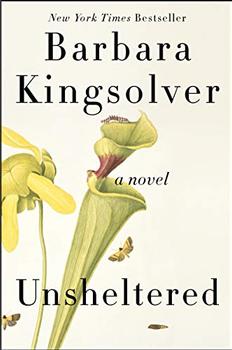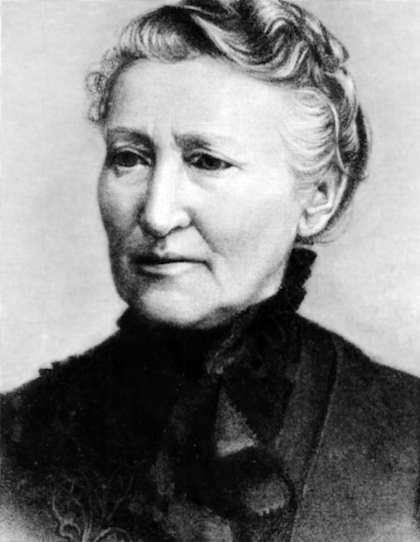Summary | Excerpt | Reading Guide | Discuss | Reviews | Beyond the Book | Read-Alikes | Genres & Themes | Author Bio

A Novel
by Barbara KingsolverThis article relates to Unsheltered
Mary Treat
 Although the two protagonists of Barbara Kingsolver's Unsheltered are fictional, she includes historical figures in her 19th-century story line. Chief among these is Mary Treat, a rare female scientist who deserves to be better known than she is – I had no idea until I got to the Acknowledgments at the back of the book that Treat was a real person. Born Mary Davis in Trumansburg, New York in September 1830, she was the daughter of a Methodist minister. She grew up there and in Ohio and was educated by turns at a private girls' academy and a public school.
Although the two protagonists of Barbara Kingsolver's Unsheltered are fictional, she includes historical figures in her 19th-century story line. Chief among these is Mary Treat, a rare female scientist who deserves to be better known than she is – I had no idea until I got to the Acknowledgments at the back of the book that Treat was a real person. Born Mary Davis in Trumansburg, New York in September 1830, she was the daughter of a Methodist minister. She grew up there and in Ohio and was educated by turns at a private girls' academy and a public school.
In 1863 she married Dr. Joseph Burrell Treat, a professor and abolitionist. After a time spent in Iowa, the couple moved to Vineland, New Jersey in 1869. It was here that Mary began her scientific research, mostly into plants and insects, and her first article was published in The American Entomologist soon afterwards. She and her husband initially collaborated on her entomological studies, but they separated in 1874. In the novel Kingsolver offers two reasons for the failure of the marriage: Dr. Treat had gotten caught up in spiritualism, which Mary dismisses as nonsense; and he had taken up with another woman.
 From this point on Mary had to support herself by her writing. She published popular science articles in publications like Harper's, Lippincott's, The American Naturalist, and Hearth and Home. Her essays and books often arose from observations made in her own garden or nearby in New Jersey's Pine Barrens. For instance, in Unsheltered, when Thatcher Greenwood first meets Mary she's staring at the ants on her lawn – which later become the subject of her first book, Chapters on Ants (1879). Starting in 1871, Mary corresponded with Charles Darwin for the five years he was studying carnivorous plants. In the novel, Kingsolver has Thatcher visit Mary while she's conducting an experiment with a Venus flytrap, allowing it to nibble at her fingertip. Darwin references Mary in his 1875 book Insectivorous Plants.
From this point on Mary had to support herself by her writing. She published popular science articles in publications like Harper's, Lippincott's, The American Naturalist, and Hearth and Home. Her essays and books often arose from observations made in her own garden or nearby in New Jersey's Pine Barrens. For instance, in Unsheltered, when Thatcher Greenwood first meets Mary she's staring at the ants on her lawn – which later become the subject of her first book, Chapters on Ants (1879). Starting in 1871, Mary corresponded with Charles Darwin for the five years he was studying carnivorous plants. In the novel, Kingsolver has Thatcher visit Mary while she's conducting an experiment with a Venus flytrap, allowing it to nibble at her fingertip. Darwin references Mary in his 1875 book Insectivorous Plants.
Mary, like Darwin, studied carnivorous plants. She was one of only four female botanists to be published in America at the time, and over the course of her career she published 76 articles and five more books (Injurious Insects of the Farm and Garden, 1882; Home Studies in Nature, 1885; Through a Microscope, 1886; My Garden Pets, 1887; and Asa Gray: His Life and Work, 1890). Her style was clear and accessible to lay readers, which was a change from the lofty, aloof prose of many of the male naturalists of the time.
Archival material relating to Mary Treat's life is kept at the Vineland Historical and Antiquarian Society, and Harvard University herbarium holds a selection of her scientific specimens. Her letters to Darwin are at the Cambridge University Library. She died in April 1923, aged 92, in Pembroke, New York.
Charles Landis
 Charles Landis (1833–1900) was a property developer who founded both Vineland and Sea Isle City. In 1861 he bought 20,000 acres near Millville, New Jersey, which had a railway connection to Philadelphia. Landis Avenue ran through the center of Vineland, which was 1 mile square and surrounded by the mostly agricultural Landis Township. House construction began the following year. The town was teetotal and Landis encouraged the cultivation of grapes for juice rather than wine - Thomas Bramwell Welch started Welch's Grape Juice nearby. There were fairly strict local regulations on houses and property maintenance. Indeed, Kingsolver presents Landis as something of a demagogue, and he was involved in an infamous local trial (beware spoilers!) – the details of this in the novel are all historical, even though they may seem too strange to be true.
Charles Landis (1833–1900) was a property developer who founded both Vineland and Sea Isle City. In 1861 he bought 20,000 acres near Millville, New Jersey, which had a railway connection to Philadelphia. Landis Avenue ran through the center of Vineland, which was 1 mile square and surrounded by the mostly agricultural Landis Township. House construction began the following year. The town was teetotal and Landis encouraged the cultivation of grapes for juice rather than wine - Thomas Bramwell Welch started Welch's Grape Juice nearby. There were fairly strict local regulations on houses and property maintenance. Indeed, Kingsolver presents Landis as something of a demagogue, and he was involved in an infamous local trial (beware spoilers!) – the details of this in the novel are all historical, even though they may seem too strange to be true.
Mary Treat, courtesy of the Vineland Historical and Antiquarian Society.
A page from Mary Treat's Home Studies in Nature
Charles Landis
Filed under People, Eras & Events
![]() This "beyond the book article" relates to Unsheltered. It originally ran in October 2018 and has been updated for the
October 2019 paperback edition.
Go to magazine.
This "beyond the book article" relates to Unsheltered. It originally ran in October 2018 and has been updated for the
October 2019 paperback edition.
Go to magazine.
Sometimes I think we're alone. Sometimes I think we're not. In either case, the thought is staggering.
Click Here to find out who said this, as well as discovering other famous literary quotes!
Your guide toexceptional books
BookBrowse seeks out and recommends the best in contemporary fiction and nonfiction—books that not only engage and entertain but also deepen our understanding of ourselves and the world around us.